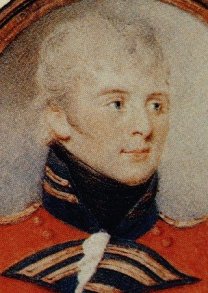Loftus William Otway facts for kids
Quick facts for kids
Sir Loftus William Otway
|
|
|---|---|

Loftus William Otway
|
|
| Born | 28 April 1775 Castle Otway, Tipperary |
| Died | 7 June 1854 Grosvenor Square, London |
| Allegiance | |
| Service/ |
|
| Years of service | 1796 to 1819 |
| Rank | General |
| Battles/wars | French Revolutionary Wars Irish Rebellion of 1798 • Battle of Vinegar Hill Napoleonic Wars • Battle of Sahagún • Battle of Benavente • Battle of Busaco • Battle of Albuera |
| Awards | Knighthood Companion of the Bath Knight of the Order of Charles III |
General Sir Loftus William Otway was an important British cavalry commander. He served during the Peninsula War and fought under famous leaders like Sir John Moore and Wellington. He also helped train Portuguese soldiers. Otway retired after the war and received many awards for his service.
Early Military Life
Loftus Otway was born on April 28, 1775, in Castle Otway, Tipperary, Ireland. His family had a strong history in the military. His father was an officer, and his older brother became an admiral.
Otway joined the army when he was 21 years old in 1796. This was during the French Revolutionary Wars. He started as a cornet in the 5th Dragoon Guards. Soon after, he became a lieutenant. His unit was sent to Ireland in 1796.
He was in Ireland during the Irish Rebellion of 1798. This was a big uprising against British rule. Otway was at the Battle of Vinegar Hill on June 21, 1798. His unit helped to control the rebels during this important battle.
Fighting in the Napoleonic Wars
Otway continued to rise through the army ranks. He became a captain in 1798 and a major in 1803. This was when the Napoleonic Wars began.
In 1804, Otway moved to the 8th Dragoons. He spent some time serving in Canada. Later, in 1807, he returned to Europe. He volunteered to serve in Portugal and Spain with the 18th Light Dragoons.
He joined Sir John Moore's army in Galicia. Otway's regiment played a key role in protecting the army's retreat to Corunna. They fought in several cavalry battles, including Sahagún and Benavente. During these fights, Otway showed great bravery. He even captured a French general!
After being evacuated from Corunna in 1809, Otway returned to England. He later went back to the Peninsula to command a Portuguese cavalry brigade. He fought in battles like the Battle of Busaco in 1810. He also had a victory at Campo Mayor in 1811.
At the Battle of Albuera, Otway performed well on the left side of the battle. In 1812, he returned to England. He later went back to Portugal to help train Portuguese and Spanish cavalry regiments. In 1813, he was promoted to full colonel.
Life After the War
After the war ended, Otway retired from active military service. However, he remained involved in military planning. In 1815, he was knighted in London. This meant he received the title "Sir." He also became a companion of the Order of the Bath.
In 1819, he was promoted to major-general. In 1822, he was made a Spanish Knight of the Order of Charles III. He married Frances Blicke and they had two children.
Otway continued to receive promotions. In 1837, he became a lieutenant general. In 1840, he became Colonel of the 84th Regiment of Foot. His final promotion came in 1851, when he became a full general.
Sir Loftus William Otway passed away on June 7, 1854, in London. He was buried at Highgate Cemetery.
Images for kids


